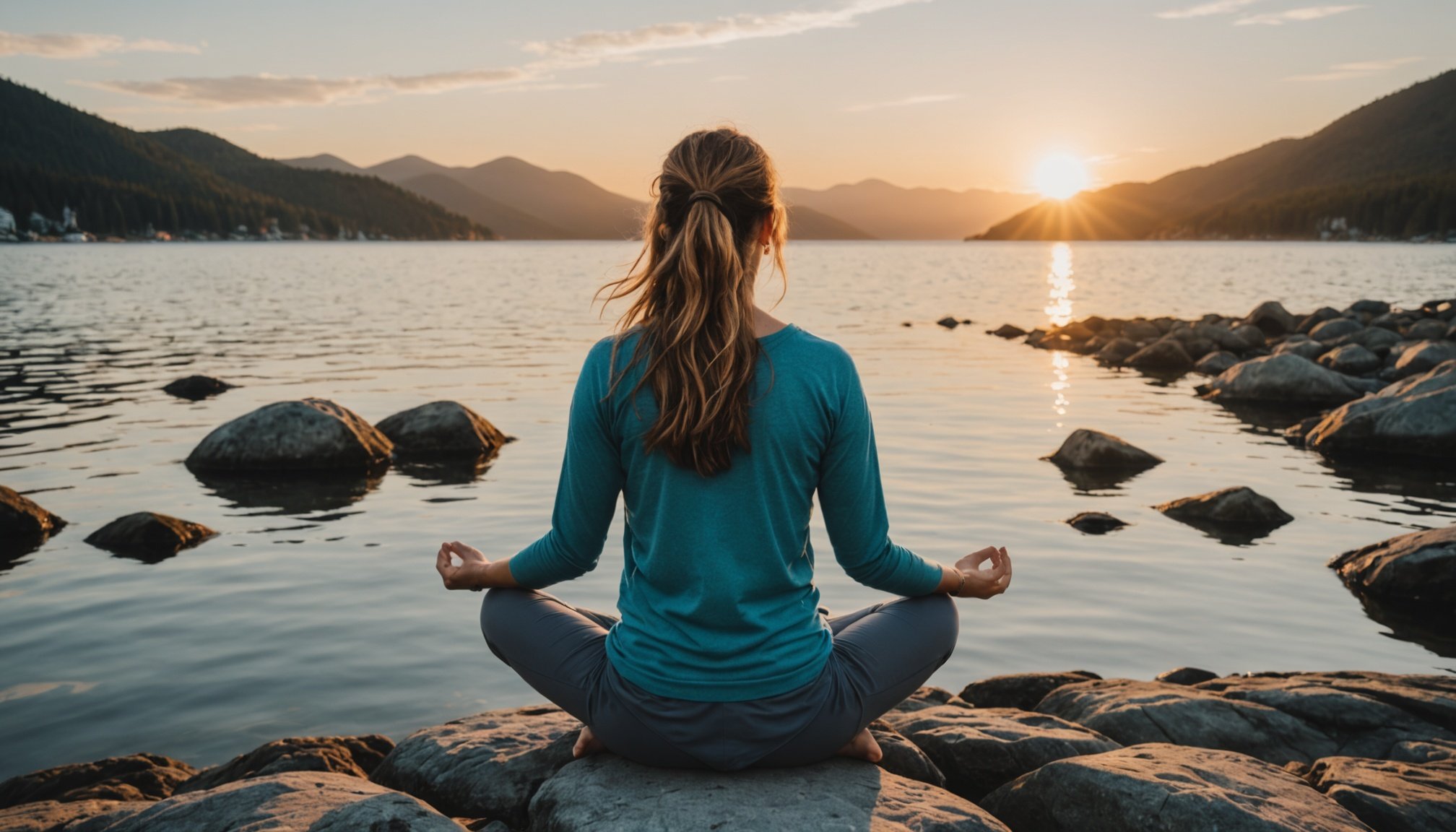Unlocking Serenity: The Transformative Power of Mind-Body Practices for Chronic Stress Relief
In today’s fast-paced world, chronic stress has become an unwelcome companion for many of us. The constant pressure to perform, the relentless pace of modern life, and the myriad of responsibilities we juggle can leave us feeling drained, anxious, and disconnected from our inner selves. However, there is a way to break free from this cycle of stress and find serenity: through the powerful practices of mind-body connection.
Understanding Chronic Stress
Before we dive into the solutions, it’s essential to understand the impact of chronic stress on our lives. Chronic stress is not just a feeling of being overwhelmed; it has real and profound effects on both our physical and mental health.
Also read : Exploring the Environmental Triggers Behind Autoimmune Disease Incidence
Physical Consequences
Chronic stress can lead to a range of physical issues, including:
- Muscle Tension: Stress causes our muscles to tighten, leading to chronic pain and discomfort[1].
- Sleep Disturbances: Stress can disrupt sleep patterns, making it difficult to get the restful sleep our bodies need[3].
- Cardiovascular Problems: Chronic stress can increase blood pressure and heart rate, putting a strain on the cardiovascular system[4].
Mental and Emotional Consequences
The mental and emotional toll of chronic stress is just as significant:
This might interest you : Unlocking Relief: How Acupuncture Can Alleviate Fibromyalgia Symptoms and Enhance Well-Being
- Anxiety and Depression: Chronic stress can exacerbate anxiety and depression, making it harder to manage emotions and maintain a positive outlook[3].
- Cognitive Impairment: Stress can affect concentration, memory, and decision-making abilities[3].
- Emotional Instability: It can lead to mood swings, irritability, and a general feeling of being on edge[2].
The Power of Mind-Body Practices
Mind-body practices offer a holistic approach to managing chronic stress, focusing on the interconnectedness of the mind, body, and spirit. Here are some of the most effective practices:
Yoga: A Path to Inner Peace
Yoga, particularly Yin yoga, is a gentle yet powerful practice that combines static poses, deep breathing, and meditation to promote relaxation and reduce stress.
How Yin Yoga Works
- Static Poses: Yin yoga involves holding passive poses for extended periods, which helps in releasing tension stored in the connective tissues of the body. This relaxation of the physical body translates into mental calmness[1].
- Breathing Techniques: The practice emphasizes deep, slow breathing, which activates the parasympathetic nervous system, responsible for relaxation and well-being[1].
- Meditation and Mindfulness: Yin yoga integrates meditation and mindfulness, encouraging participants to focus on the present moment and disconnect from daily worries[1].
Benefits of Yin Yoga
- Reduces Muscle Tension: Deep stretches and prolonged holds help in releasing physical tension and reducing chronic pain[1].
- Promotes Mental Calmness: The meditative nature of Yin yoga helps in calming the nervous system, reducing anxiety and stress levels[1].
- Enhances Emotional Balance: Regular practice improves emotional management and fosters a more serene state of mind[1].
Meditation: A Tool for Mental Clarity
Meditation is another potent tool for stress relief, offering a range of techniques to suit different needs and preferences.
Techniques for Meditation
- Focused Breathing: Concentrate on your breath, feeling the air move in and out of your body. This helps in calming the mind and reducing stress[2].
- Body Scan: Lie down or sit comfortably and focus on different parts of your body, releasing any tension as you go. This practice promotes physical relaxation and mental calmness[2].
- Mindfulness Meditation: Pay attention to the present moment, observing your thoughts and feelings without judgment. This helps in reducing mental agitation and improving emotional balance[3].
Benefits of Meditation
- Reduces Stress and Anxiety: Regular meditation practice has been shown to lower stress and anxiety levels by promoting relaxation and improving mood[3].
- Improves Sleep: Meditation can help in regulating sleep patterns, leading to better rest and recovery[3].
- Enhances Cognitive Function: It improves concentration, memory, and decision-making abilities by training the mind to stay focused and calm[3].
Breathing Exercises: The Simple yet Effective Approach
Breathing exercises are a simple yet powerful way to reduce stress and promote relaxation. Here’s how you can incorporate them into your daily life:
Deep Breathing Exercises
- Diaphragmatic Breathing: Also known as belly breathing, this involves breathing deeply into your diaphragm rather than shallowly into your chest. This type of breathing helps in activating the parasympathetic nervous system, promoting relaxation[2].
- 4-7-8 Breathing: This technique involves breathing in through your nose for a count of 4, holding your breath for a count of 7, and exhaling through your mouth for a count of 8. This can help in calming the nervous system and reducing stress[4].
Holistic Approaches to Stress Relief
In addition to specific practices, adopting a holistic approach to life can significantly help in managing chronic stress.
Healthy Lifestyle Habits
- Balanced Diet: Eating a balanced diet rich in nutrients helps in maintaining physical and mental health. Avoid processed foods and opt for whole, organic foods as much as possible[3].
- Regular Exercise: Physical activity, such as walking or any form of exercise you enjoy, can help in reducing stress levels and improving mood. It also promotes better sleep and overall physical health[4].
- Quality Sleep: Ensure you get enough sleep each night. Aim for 7-8 hours of sleep to help your body and mind recover from the day’s stress[3].
Self-Care and Connection
Self-care and connection with others are crucial for managing stress.
Self-Care Practices
- Time for Yourself: Make time each day to do something you enjoy, whether it’s reading, taking a bath, or simply sitting in silence. This helps in rejuvenating your mind and body[1].
- Social Support: Connect with friends, family, or a support group. Social support can provide emotional comfort and help you feel less isolated[2].
Building Body Connection
- Body Awareness: Practice body awareness by paying attention to your physical sensations. This can help in identifying and releasing tension before it becomes chronic[1].
- Physical Activities: Engage in physical activities that promote body connection, such as yoga, tai chi, or any form of exercise that makes you feel grounded and connected to your body[1].
Practical Insights and Actionable Advice
Here are some practical tips to help you integrate these practices into your daily life:
Starting Your Mind-Body Journey
- Begin Small: Start with short sessions of meditation or yoga and gradually increase the duration as you become more comfortable with the practices.
- Find What Works for You: Experiment with different techniques until you find what resonates with you the most.
- Make It a Habit: Incorporate these practices into your daily routine, just like brushing your teeth or taking a shower.
Creating a Supportive Environment
- Dedicate a Space: Designate a quiet, comfortable space for your mind-body practices.
- Use Guided Resources: Utilize guided meditation apps, yoga videos, or books to help you get started.
- Seek Professional Help: If you find it challenging to manage your stress on your own, consider seeking help from a mental health professional.
Testimonials and Success Stories
Real people have found significant relief from chronic stress through these mind-body practices.
Delphine’s Story
“Today, I am no longer angry and I am more serene. I have learned to take a step back to analyze the situation and to rely on my surroundings to help me. I can handle stress better now,” says Delphine, who credits programs like ThéraSéréna for her improved mental health[2].
Maité’s Experience
“With ThéraSéréna, I learned to dare and it’s not as simple as it sounds. It’s an extremely complete program that accompanies you day by day. The varied and adapted exercises and tools motivate me to move forward,” shares Maité, who found the program very comprehensive and helpful[2].
Comparative Table: Mind-Body Practices for Stress Relief
Here is a comparative table highlighting the key aspects of different mind-body practices:
| Practice | Description | Benefits | Ease of Start |
|---|---|---|---|
| Yin Yoga | Static poses, deep breathing, meditation | Reduces muscle tension, promotes mental calmness, enhances emotional balance | Moderate (requires some flexibility and patience) |
| Meditation | Focused breathing, body scan, mindfulness | Reduces stress and anxiety, improves sleep, enhances cognitive function | Easy (can start with short sessions) |
| Breathing Exercises | Deep breathing, 4-7-8 breathing | Activates parasympathetic nervous system, promotes relaxation | Easy (can be done anywhere) |
| Holistic Lifestyle | Balanced diet, regular exercise, quality sleep | Maintains physical and mental health, reduces stress levels | Moderate (requires consistent effort) |
Chronic stress is a pervasive issue that affects many aspects of our lives, but it is not insurmountable. By embracing mind-body practices such as yoga, meditation, and breathing exercises, we can find a path to serenity and relief. These practices not only reduce stress and anxiety but also promote overall physical and mental health.
As Delphine so aptly put it, “I have learned to take a step back to analyze the situation and to rely on my surroundings to help me.” By taking that first step towards mind-body connection, you can begin your journey towards a more balanced, peaceful life.
Final Thoughts
Incorporating mind-body practices into your daily routine is a powerful way to manage chronic stress. Here are some final thoughts to keep in mind:
- Be Patient: These practices take time to show their full benefits. Be patient and consistent.
- Seek Help When Needed: Don’t hesitate to seek professional help if you find it challenging to manage your stress on your own.
- Make It a Lifestyle: These practices are not just temporary fixes but should be integrated into your lifestyle for long-term benefits.
By embracing these holistic approaches, you can unlock the transformative power of mind-body connection and find the serenity you deserve in a world filled with stress and anxiety.











